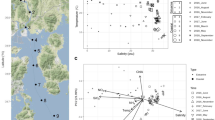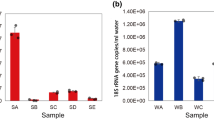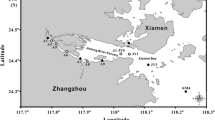Abstract
The Lianjiang coast in the East China Sea is a typical subtropical marine ecosystem, and shellfish cultivation occupies almost all of the available tidal flats. Many studies have investigated the effects of shellfish cultivation on benthic organisms and sediments, while the impact of shellfish cultivation on plankton ecosystems is still poorly understood. This study investigated the biogeographical patterns of microeukaryotic communities from Lianjiang coastal waters in four seasons using 18S ribosomal RNA gene amplicon sequencing. Microeukaryotes were mainly comprised of Dinoflagellata, Diatomea, Arthropoda, Ciliophora, Chlorophyta, Protalveolata, Cryptophyceae, and Ochrophyta, and presented significant differences in three habitats (the aquaculture area, confluent area, and offshore area) and four seasons. Similarity percentage analysis revealed that Paracalanus parvus, Heterocapsa rotundata, Bestiolina similis, and five additional key taxa contributed to spatio-temporal differences. Seasonal environmental and spatial factors explained 27.47% of microeukaryotic community variation on average, with 11.11% of the variation shared. Environmental variables, particularly depth, pH, and nitrite concentration, were strongly associated with the microeukaryotic community compositions. The neutral community model further demonstrated that stochastic processes were sufficient in sha** substantial variation in microeukaryotic communities across four seasons, which may reveal the remaining unexplained microeukaryotic community variation. We further divided four seasons into the aquaculture stages and non-aquaculture stages, and speculated that aquaculture activities may increase the dispersal limitation of microeukaryotes in coastal waters, especially for the big bodied-microbes like Arthropoda. The results provide a better understanding of the biogeographical patterns, processes, and mechanisms of microeukaryotic communities near shellfish cultivation.







Similar content being viewed by others
Data Availability
The data availability statement was preferred in the materials and methods.
References
Anderson SR, Harvey EL (2020) Temporal variability and ecological interactions of parasitic marine Syndiniales in coastal protist communities. Msphere 5:e00209-e220
AQSIQ P, AQSIQ (2007) The specification for marine monitoring of China‐Part 4: seawater analysis (GB 17378.4‐2007)[J]. General Administration of Quality Supervision, Inspection and Quarantine of People’s Republic of China
Backe-Hansen P, Throndsen J (2002) Occurrence of pico-and smaller nanoplanktonic flagellates in the inner Oslofjord, eastern Norway, during the breeding season of the blue mussel (Mytilus edulis L.). Sarsia 87:65–74
Baek MJ, Lee Y-J, Choi K-S, Lee WC, Park HJ, Kwak JH, Kang C-K (2014) Physiological disturbance of the Manila clam, Ruditapes philippinarum, by altered environmental conditions in a tidal flat on the west coast of Korea. Mar Pollut Bull 78:137–145
Bahram M, Kohout P, Anslan S, Harend H, Abarenkov K, Tedersoo L (2016) Stochastic distribution of small soil eukaryotes resulting from high dispersal and drift in a local environment. ISME J 10:885–896
Blanchet FG, Legendre P, Borcard D (2008) Forward selection of explanatory variables. Ecology 89:2623–2632
Boaventura C, Coelho F, Martins P, Pires A, Duarte L, Uetanabaro A, Cleary D, Gomes N (2018) Micro-eukaryotic plankton diversity in an intensive aquaculture system for production of Scophthalmus maximus and Solea senegalensis. Aquaculture 490:321–328
Borcard D, Legendre P (2002) All-scale spatial analysis of ecological data by means of principal coordinates of neighbour matrices. Eco Model 153(1–2):51–68. https://doi.org/10.1016/S0304-3800(01)00501-4
Borcard D, Legendre P, Drapeau P (1992) Partialling out the spatial component of ecological variation. Ecology 73:1045–1055
Brown M, Jeffrey S, Volkman J, Dunstan G (1997) Nutritional properties of microalgae for mariculture. Aquaculture 151:315–331
Callahan BJ, McMurdie PJ, Rosen MJ, Han AW, Johnson AJA, Holmes SP (2016) DADA2: high-resolution sample inference from Illumina amplicon data. Nat Methods 13:581–583
Caporaso JG, Kuczynski J, Stombaugh J, Bittinger K, Bushman FD, Costello EK, Fierer N, Peña AG, Goodrich JK, Gordon JI (2010) QIIME allows analysis of high-throughput community sequencing data. Nat Methods 7:335–336
Chapin Iii FS, Zavaleta ES, Eviner VT, Naylor RL, Vitousek PM, Reynolds HL, Hooper DU, Lavorel S, Sala OE, Hobbie SE (2000) Consequences of changing biodiversity. Nature 405:234–242. https://doi.org/10.1038/35012241
Chen W, Ren K, Isabwe A, Chen H, Liu M, Yang J (2019) Stochastic processes shape microeukaryotic community assembly in a subtropical river across wet and dry seasons. Microbiome 7:1–16
Clarke KR, Gorley RN, Somerfield PJ, Warwick RM (2014) Change in marine communities: an approach to statistical analysis and interpretation, 3rd edn.. Plymouth, Primer-E Ltd.
Cordier T, Alonso-Sáez L, Apothéloz-Perret-Gentil L, Aylagas E, Bohan D, Bouchez A, Chariton A, Creer E, Frühe L, Keck F, Keeley N, Laroche O, Leese F, Pochon X, Stoeck T, Pawlowski J, Lanzén A (2021) Ecosystems monitoring powered by environmental genomics: a review of current strategies with an implementation roadmap. Mol Ecol 30:2937–2958
De Luca D, Kooistra WH, Sarno D, Gaonkar CC, Piredda R (2019) Global distribution and diversity of Chaetoceros (Bacillariophyta, Mediophyceae): integration of classical and novel strategies. PeerJ 7:e7410
De Schryver P, Vadstein O (2014) Ecological theory as a foundation to control pathogenic invasion in aquaculture. ISME J 8:2360–2368
Dennett MR, Mathot S, Caron DA, Smith WO Jr, Lonsdale DJ (2001) Abundance and distribution of phototrophic and heterotrophic nano-and microplankton in the southern Ross Sea. Deep-Sea Res Pt II 48:4019–4037
Diniz-Filho JAF, Soares TN, Lima JS, Dobrovolski R, Landeiro VL, d C Telles MP, Rangel TF, Bini LM (2013) Mantel test in population genetics. Genet Mo Biol 36:475–485
Duarte LN, Coelho FJ, Cleary DF, Bonifácio D, Martins P, Gomes NC (2019) Bacterial and microeukaryotic plankton communities in a semi-intensive aquaculture system of sea bass (Dicentrarchus labrax): a seasonal survey. Aquaculture 503:59–69
Finlay BJ (2002) Global dispersal of free-living microbial eukaryote species. Science 296:1061–1063
Hanson CA, Fuhrman JA, Horner-Devine MC, Martiny JB (2012) Beyond biogeographic patterns: processes sha** the microbial landscape. Nat Rev Microbiol 10:497–506
Huo Y, Wei Z, Liu Q, Yang F, Long L, Zhang Q, Bi H, He Q, He P (2018) Distribution and controlling factors of phytoplankton assemblages associated with mariculture in an eutrophic enclosed bay in the East China Sea. Acta Oceanol Sin 37:102–112
**g H, Rocke E, Kong L, **a X, Liu H, Landry M (2015) Protist communities in a marine oxygen minimum zone off Costa Rica by 454 pyrosequencing. Biogeosciences 12:13483–13509
Kim DY, Countway PD, Jones AC, Schnetzer A, Yamashita W, Tung C, Caron DA (2014) Monthly to interannual variability of microbial eukaryote assemblages at four depths in the eastern North Pacific. ISME J 8:515–530
Kong N, Liu Z, Yu Z, Fu Q, Li H, Zhang Y, Fang X, Zhang F, Liu C, Wang L, Song L (2022) Dynamics of phytoplankton community in scallop farming waters of the Bohai Sea and North Yellow Sea in China[J]. BMC Ecol Evol 22(1):1–12
Lepère C, Domaizon I, Taïb N, Mangot J-F, Bronner G, Boucher D, Debroas D (2013) Geographic distance and ecosystem size determine the distribution of smallest protists in lacustrine ecosystems. FEMS Microbiol Ecol 85:85–94
Liang Y, Zhang G, Wan A, Zhao Z, Wang S, Liu Q (2019) Nutrient-limitation induced diatom-dinoflagellate shift of spring phytoplankton community in an offshore shellfish farming area. Mar Pollut Bull 141:1–8
Lima-Mendez G, Faust K, Henry N, Decelle J, Colin S, Carcillo F, Chaffron S, Ignacio-Espinosa JC, Roux S, Vincent F (2015) Determinants of community structure in the global plankton interactome. Science 348:1262073
Liu S, Sun S, Wang Z, Chen S, Wen Q (2014) Change in distribution of plankton as affected by environmental factors in the estuaries of Feiyunjiang River and Aojiang River in summer and autumn. J Ecol Rural Environ 30:430–437
Liu T, Zhang AN, Wang J, Liu S, Jiang X, Dang C, Ma T, Liu S, Chen Q, **e S (2018) Integrated biogeography of planktonic and sedimentary bacterial communities in the Yangtze River. Microbiome 6:1–14
Lounas R, Kasmi H, Chernai S, Amarni N, Hamdi B (2021) Dynamics of the genus Ostreopsis (Gonyaulacales, Dinophyceae) in a Mediterranean fish farm. Environ Monit Assess 193:1–12
McKinnon A, Duggan S, Nichols P, Rimmer M, Semmens G, Robino B (2003) The potential of tropical paracalanid copepods as live feeds in aquaculture. Aquaculture 223:89–106
Millette N, Pierson J, Aceves A, Stoecker D (2017) Mixotrophy in Heterocapsa rotundata: a mechanism for dominating the winter phytoplankton. Limnol Oceanogr 62:836–845
Millette NC, Stoecker DK, Pierson J (2015) Top-down control by micro-and mesozooplankton on winter dinoflagellate blooms of Heterocapsa rotundata. Aquat Microb Ecol 76:15–25
Mosbahi N, Pezy J-P, Dauvin J-C, Neifar L (2016) Immediate effect of clam harvesting on intertidal benthic communities in the mudflat zones of kneiss islands (central mediterranean sea). J Aquac Res Development 7:2
Naylor RL, Goldburg RJ, Primavera JH, Kautsky N, Beveridge M, Clay J, Folke C, Lubchenco J, Mooney H, Troell M (2000) Effect of aquaculture on world fish supplies. Nature 405:1017–1024
Not F, Massana R, Latasa M, Marie D, Colson C, Eikrem W, Pedrós-Alió C, Vaulot D, Simon N (2005) Late summer community composition and abundance of photosynthetic picoeukaryotes in Norwegian and Barents Seas. Limnol Oceanogr 50:1677–1686
Nuccio C, Melillo C, Massi L, Innamorati M (2003) Phytoplankton abundance, community structure and diversity in the eutrophicated Orbetello lagoon (Tuscany) from 1995 to 2001. Oceanol Acta 26:15–25
Oksanen J, Kindt R, Legendre P, O’Hara B, Stevens MHH, Oksanen MJ, Suggests M (2007) The vegan package. Community Ecol Packag 10:719
Peng T, Zhu Z, Du J, Liu J (2021) Effects of nutrient-rich submarine groundwater discharge on marine aquaculture: a case in Lianjiang, East China Sea. Sci Total Environ 786:147388
Prins TC, Smaal AC, Dame RF (1997) A review of the feedbacks between bivalve grazing and ecosystem processes. Aquat Ecol 31:349–359
Santoferrara L, Burki F, Filker S, Logars R, Dunthorn M, McManus GB (2020) Perspectives from ten years of protist studies by high-throughput metabarcoding. J Eukaryot Microbiol 67:612–622
Schloss PD, Westcott SL, Ryabin T, Hall JR, Hartmann M, Hollister EB, Lesniewski RA, Oakley BB, Parks DH, Robinson CJ (2009) Introducing mothur: open-source, platform-independent, community-supported software for describing and comparing microbial communities. Appl Environ Microb 75:7537–7541
Sellner K, Lacouture R, Cibik S, Brindley A, Brownlee S (1991) Importance of a winter dinoflagellate-microflagellate bloom in the Patuxent River estuary. Estuar Coast Shelf S 32:27–42
Shao Q, Lin Z, Zhou C, Zhu P, Yan X (2020) Succession of bacterioplankton communities over complete Gymnodinium-diatom bloom cycles. Sci Total Environ 709:135951
Sloan WT, Lunn M, Woodcock S, Head IM, Nee S, Curtis TP (2006) Quantifying the roles of immigration and chance in sha** prokaryote community structure. Environ Microbiol 8:732–740
Sloan WT, Woodcock S, Lunn M, Head IM, Curtis TP (2007) Modeling taxa-abundance distributions in microbial communities using environmental sequence data. Microb Ecol 53:443–455
Smith TW, Lundholm JT (2010) Variation partitioning as a tool to distinguish between niche and neutral processes. Ecography 33:648–655
Sun X, Sun S, Li C, Zhang G (2008) Seasonal and spatial variation in abundance and egg production of Paracalanus parvus (Copepoda: Calanoida) in/out Jiaozhou Bay, China Estuar. Coast Shelf S 79:637–643
Waldock M, Nascimento I (1979) The triacylglycerol composition of Crassostrea gigas larvae fed on different algal diets. Mar Biol Lett 1:77–86
Wang Y, Liu L, Chen H, Yang J (2015) Spatiotemporal dynamics and determinants of planktonic bacterial and microeukaryotic communities in a Chinese subtropical river. Appl Microbiol Biot 99:9255–9266
Wei H, Sun J, Moll A, Zhao L (2004) Phytoplankton dynamics in the Bohai Sea—observations and modelling. J Marine Syst 44:233–251
Worden AZ, Follows MJ, Giovannoni SJ, Wilken S, Zimmerman AE, Keeling PJ (2015) Rethinking the marine carbon cycle: factoring in the multifarious lifestyles of microbes. Science 347:1257594
**ong J, Chen H, Hu C, Ye X, Kong D, Zhang D (2015) Evidence of bacterioplankton community adaptation in response to long-term mariculture disturbance. Sci Rep-UK 5:1–11
Zhou J, Ning D (2017) Stochastic community assembly: does it matter in microbial ecology? Microbiol Mol Biol Rev 81(4):e00002-17. https://doi.org/10.1128/mmbr.00002-17
Zhang Z, Li J, Li H, Wang L, Zhou Y, Li S, Zhang Z, Deng Y (2023) Environmental DNA metabarcoding reveals the influence of human activities on microeukaryotic plankton along the Chinese coastline. Water Res 233:119730
Acknowledgements
We thank LetPub for linguistic assistance during manuscript preparation.
Funding
This work was supported financially by the National Key Research and Development Program of China (2018YFD0900702), the Natural Science Foundation of Ningbo (2022J195), the Public Welfare Science and Technology Project of Ningbo (2022S116), and K.C. Wong Magna Fund in Ningbo University (SS).
Author information
Authors and Affiliations
Contributions
QS and CZ conceptualized the study and designed the experiment. QS performed the statistical analysis and wrote the manuscript with contributions from CZ and XY. ZL, ZX, and ZZ participated in the research cruise and collected data. CZ and XY approved the final version of the manuscript. All the authors contributed to the article and approved the submitted version.
Corresponding authors
Ethics declarations
Competing interests
The authors declare no competing interests.
Conflict of Interest
The authors declare no competing interests.
Supplementary Information
Below is the link to the electronic supplementary material.
Rights and permissions
Springer Nature or its licensor (e.g. a society or other partner) holds exclusive rights to this article under a publishing agreement with the author(s) or other rightsholder(s); author self-archiving of the accepted manuscript version of this article is solely governed by the terms of such publishing agreement and applicable law.
About this article
Cite this article
Shao, Q., Lin, Z., Xu, Z. et al. Integrated Biogeography and Assembly Mechanisms of Microeukaryotic Communities in Coastal Waters Near Shellfish Cultivation. Microb Ecol 86, 2560–2573 (2023). https://doi.org/10.1007/s00248-023-02256-0
Received:
Accepted:
Published:
Issue Date:
DOI: https://doi.org/10.1007/s00248-023-02256-0




